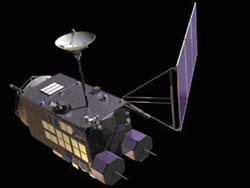SELENE (Selenological and Engineering Explorer)

SELENE (Selenological and Engineering Explorer) is a Japanese mission to study the origin and evolution of the Moon, and help develop the techniques needed
for future lunar exploration and utilization. Following the many trips to
the Moon in the 1960s and 1970s, our nearest celestial companion in space
fell out of space-exploration favor. Russia's Luna 24 was the last lunar lander, a quarter of a century ago. SELENE gave scientists
and engineers around the world a new and better assessment of the potential
for future human utilization, and even habitation, of the Moon. After a
four-year delay, SELENE was finally launched on 14 September 2007.
As is traditional with Japanese spacecraft, the three-tonne probe was given
an alternative, Japanese name, Kaguya, after a mythical princess story who
ascended to the Moon. SELENE orbited Earth before traveling the 380,000
kilometers (237,500 miles) to the Moon. There the main orbiter and two smaller sub-satellites
were be positioned 100 kilometers (60 miles) above the lunar surface.
| launch date | Sep 14, 2007 |
| launch vehicle | H-IIA |
| location | Tanegashima |
| MAIN ORBITER shape |
upper module: 2.1 m × 2.1 m × 2.8 m lower module: 2.1 m × 2.1 m × 1.4 m adaptor truss: 2.2 m octagonal column × 0.6 m |
| orbit | circular |
| altitude | approx. 100 km |
| inclination | 90° |
| attitude control | three-axis stabilization |
| OKINA (relay satellite) shape |
octagonal column (1 m × 1 m × 0.65 m), about 50 kg |
| orbit | elliptical |
| altitude | approx. 100 km × 2400 km |
| inclination | 90° |
| attitude control | spin-stabilization |
| OUNA (VRAD satellite) shape |
octagonal column (1 m × 1m × 0.65 m), about 50 kg |
| orbit | elliptical |
| altitude | approx. 100 km × 800 km |
| inclination | 90° |
| attitude control | spin-stabilization |


